📈 1. Why Small Habits Make a Big Difference: Small habits feel useless at first—but compound into massive results over time.
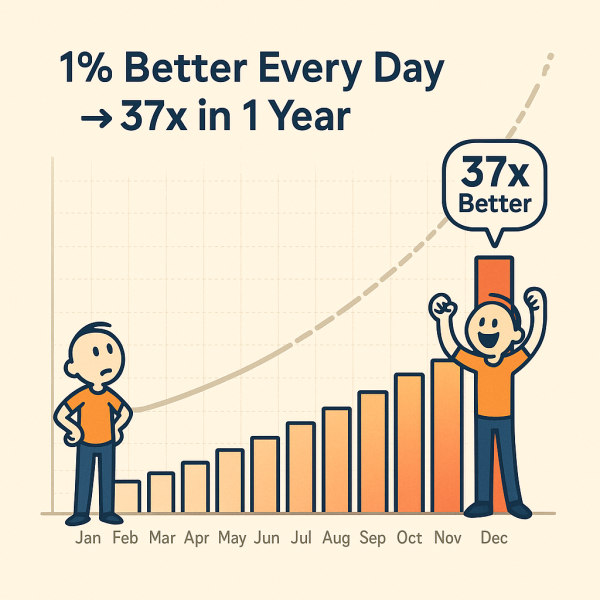
Most people try to change their lives with big, dramatic goals—like New Year’s resolutions. They go all in on a new workout, diet, or productivity hack. But a few weeks later? They’re burned out, discouraged, and back to square one.
Atomic Habits offers a different approach. Instead of chasing quick wins, James Clear shows how tiny habits—done consistently—lead to massive results. It’s like compound interest: barely noticeable at first, but life-changing over time.
The Accident That Changed Everything
James Clear wasn’t always a habit expert. In high school, he took a baseball bat to the face—literally. During a game, a teammate lost control of the bat mid-swing. It smashed into James’s skull, fracturing bones and nearly killing him.
He began having seizures, was airlifted to a hospital, and put into a medically induced coma. He couldn’t even breathe on his own. His dream of becoming a professional baseball player was gone.
The recovery was brutal. He had to relearn how to walk, speak clearly, and perform basic movements through months of physical therapy.
But when he started college at Denison University, he made a decision: to take control of his life, one small step at a time. He focused on the basics—going to bed on time, waking up early, staying organized, exercising regularly. These weren’t dramatic changes, but they were consistent.
Eventually, those small habits added up. He got straight A’s, gained 30 pounds of muscle, and climbed from the bottom of the baseball team to becoming team captain. By graduation, he was selected the top male athlete at his school.
That experience taught him something powerful: the smallest habits, repeated consistently, can lead to massive change.
Later, James began sharing his ideas about habits by writing two blog posts per week. It didn’t blow up overnight—but his consistent effort compounded. In a year, he had 30,000 subscribers. The next year, over 100,000. Today, over half a million people read his newsletter. Atomic Habits distills the best of what he’s learned—grounded in science, psychology, and real-world experience.
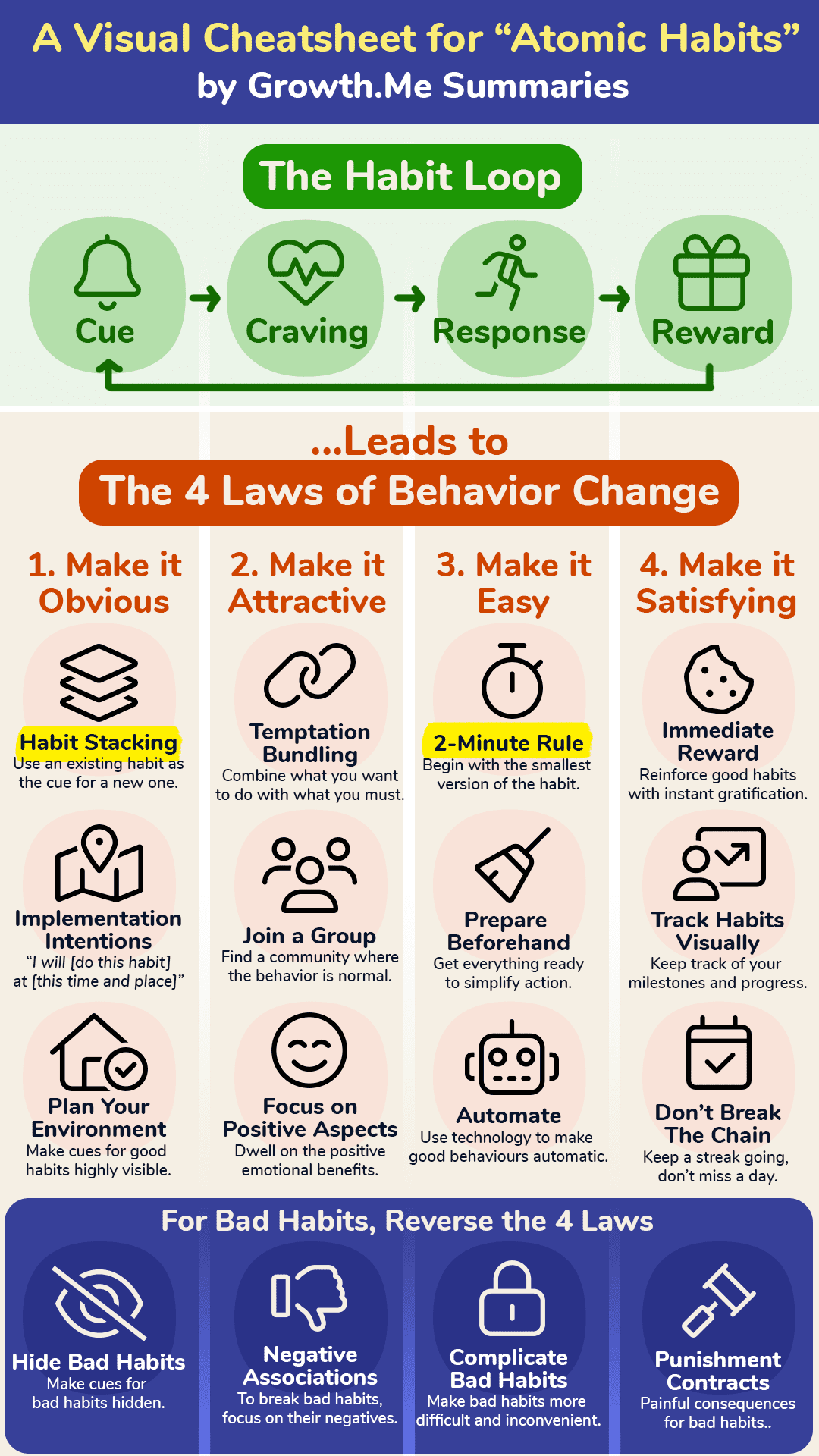
Habits = Compound Interest
We tend to chase quick wins—crash diets, 30-day challenges, or all-in makeovers. But James Clear says that’s backwards. Real change happens when you build systems and routines you can repeat every day.
He compares habits to compound interest:
- Save a little money regularly = become a millionaire over time.
- Eat a little healthier each day = transform your body and health.
- Read 10 pages a day = finish 15+ books a year.
The change feels invisible at first—like turning a plane just 1° off course. But after hours in the air, you’re thousands of miles from where you started.
In fact, if you improve just 1% each day, you’ll be 37 times better after one year.
Of course, the reverse is also true: bad habits compound too. Small things like checking your phone too often, putting off workouts, or overthinking can snowball into stress, burnout, or poor health.
By the way, if you want to dive deeper into the kind of habits that lead to long-term wealth, check out The Psychology of Money by Morgan Housel. After studying top investors like Warren Buffett, Housel argues that “financial success is not a hard science. It’s a soft skill, where how you behave is more important than what you know.”
In other words, Warren Buffett isn’t successful because he’s a math genius. He’s successful because he’s unusually patient and calm under pressure. He makes smart decisions based on independent, critical thinking—not hype—and sticks to them for decades.
Consistency and Delayed Payoffs
One of the most frustrating parts of forming new habits is not seeing progress. You start going to the gym or studying, and… nothing changes.
That’s because we expect progress to be a straight line—do the work, see the results. But in real life, it usually works differently: progress is painfully slow at first, and then suddenly speeds up all at once.
Progress is often like melting an ice cube in a cold room. The temperature of the room rises slowly… 26°, 27°, 28°… no change. Then finally at 32°, the ice melts. The breakthrough moment only comes after weeks of invisible effort.
Just because you don’t see progress doesn’t mean nothing’s happening. The work is stacking up behind the scenes.
One great example is the British cycling team. For 100 years, they were mediocre. Then a new coach came in and focused on tiny 1% improvements: slightly comfier bike seats, slightly more aerodynamic clothing, slightly better hand-washing to avoid sickness. After some time, all these tiny improvements stacked up and they began winning. Within a few years, they had won 66 Olympic medals and 5 Tour de France titles.
- Small habits feel useless at first—but compound into massive results over time.
- Don’t aim for quick wins. Aim for 1% better, every day. Like turning an airplane just a few degrees.
- Breakthroughs happen after a long period of invisible progress, like melting an ice cube.
🛠️ 2. Set Systems, Not Just Goals: Focusing on daily habits and routines works better than obsessing over big outcomes.
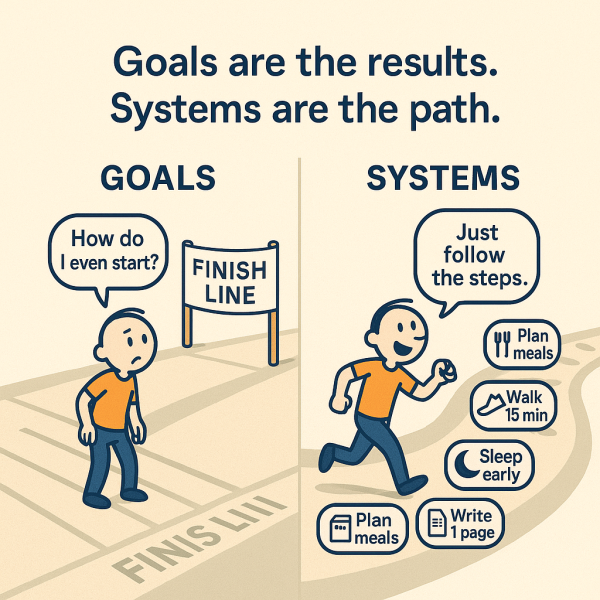
A lot of self-help advice says the key to success is to set big, clear goals. But James Clear says that’s only part of the picture—and it’s often where people go wrong.
The Problem with Goals
Why? Because goals have some built-in problems:
- Everyone has them. The person who wins the race and the one who comes last both had the same goal: to win. So clearly, goals alone aren’t enough.
- They create all-or-nothing thinking. You feel like a failure until you reach the goal… and when you do, motivation drops off a cliff.
- They delay happiness. If you believe, “I’ll be happy once I hit X,” then you’re setting yourself up to feel unfulfilled in the present.
The Power of Systems
So what should you focus on instead? The system.
A system is just the set of habits, routines, and processes that lead to your desired results.
For example, if your goal is to write a book, your system might be writing 500 words every morning. If your goal is to get fit, your system might be hitting the gym three times a week and prepping your meals. If your goal is to become a professional violinist, your system might include mastering a new piece of music every week.
Here’s why systems work:
- You’re more likely to improve. Focusing on the process helps you get 1% better every day, not just chase a far-off result.
- You’re more likely to stay motivated. Systems give you a clear plan to follow, so you don’t have to rely on willpower.
- You’re more likely to feel satisfied. Instead of waiting to feel good after you reach a goal, you enjoy the progress you’re making right now.
When you build the right system, making progress towards your goal is inevitable.
- Goals are the outcome you want. Systems are what get you there.
- Obsessing over results makes you unhappy now and unmotivated later.
- Build a system that improves you 1% each day—and let the results take care of themselves.
The classic self-help book Think and Grow Rich says: “One of the most common causes of failure is the habit of quitting when one is overtaken by temporary defeat.”
This is exactly why systems are more powerful than goals. Goals create a black-and-white view of success and failure—you either hit the target or you didn’t. That mindset makes it easy to quit when things don’t go perfectly.
But with a system, failure is just part of the process. It’s not the end—it’s feedback. You use it to adjust, improve, and keep getting 1% better over time.
🧠 3. Identity Makes Habits Stick: Lasting habits come from changing how you see yourself—not just what you want to do.
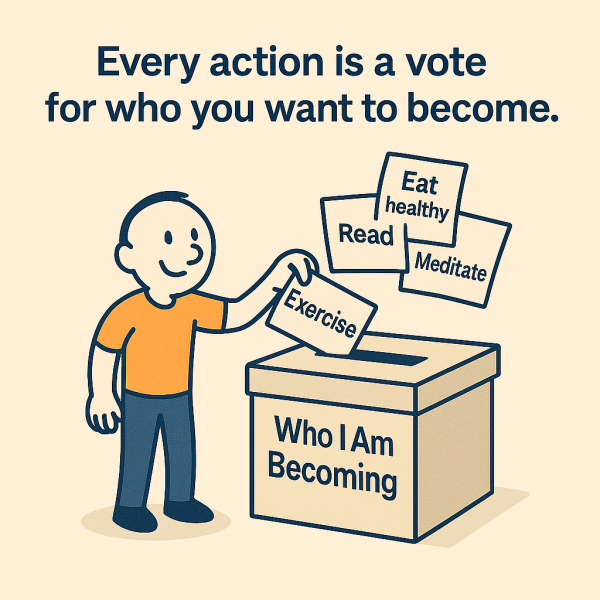
Ever wonder why it’s so hard to make a good habit stick—or to quit a bad one? According to James Clear, it’s because most people only focus on the outer layers of behavior, like setting goals or building routines.
But there’s a deeper level that matters even more: your identity.
The Three Layers of Behavior
Clear explains that behavior has three layers, like an onion:
- Goals (the outer layer) – the outcomes you want, like losing weight or writing a book
- Systems (the middle layer) – the habits and processes you follow
- Identity (the core) – what you believe about yourself
Most people focus on the surface. But if your habits don’t match your identity, they won’t last. Change that sticks starts from the inside out.
Your Actions Follow Your Identity
Identity is just your beliefs about who you are. And when your actions match those beliefs, the habit feels natural. Research shows people are more likely to vote if they think of themselves as voters, not just as people who want to vote. Another example: If you say, “I’m just bad at math,” you’re less likely to even try improving.
In the mega-bestselling self-help book The Subtle Art of Not Giving a F*ck, author Mark Manson makes a similar point: “The more something threatens your identity, the more you will avoid it.”
But the good news? You can build a new identity—by proving it to yourself with small actions.
Want to read more? Don’t just set a goal—start seeing yourself as a reader. Want to write? Become a writer.
Every time you practice the habit, you’re casting a vote for the kind of person you want to become. The more votes you cast, the more solid that identity becomes.
- Behavior change sticks when you focus on your identity, not just your goals and systems.
- Your identity shapes your habits—and your habits reinforce your identity.
- Every action is a vote for the person you’re becoming.
🔄 4. Four Steps to Change Any Habit: Every habit follows a feedback loop—understand it, and you can build any good habit and break any bad one.
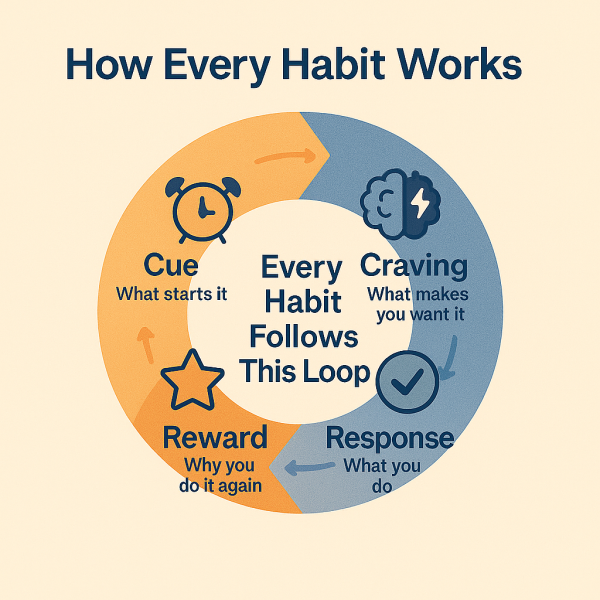
Ever wonder why you keep scrolling your phone, hitting snooze, or reaching for snacks—even when you don’t want to? It’s because every habit, good or bad, runs on the same hidden loop—and once you understand it, you can start taking control.
How Habits Work
At its core, a habit is a behavior you repeat automatically because it solves a problem. Maybe it helps you feel better, saves you effort, or gives you a little reward. Over time, that behavior becomes automatic—like flipping a light switch when you enter a dark room, or biting your nails when you’re anxious.
Over 100 years ago, a psychologist named Edward Thorndike ran an experiment with cats. He placed each cat in a box that had a lever, and when the cat pressed it, the door opened and it got food. At first, the cat would randomly paw around the box for a few minutes before it found the lever. But after a few tries, it learned what to do—and soon it was escaping in just seconds.
This is how habits form: repeat a behavior that leads to a reward, and eventually it becomes more and more automatic.
The 4-Step Habit Loop
Every habit—good or bad—follows the same four-step loop:
- Cue – Something triggers the behavior (a notification, a smell, a time of day)
- Craving – You anticipate a reward (relief, pleasure, connection)
- Response – You do the behavior
- Reward – You get the benefit, which reinforces the habit
Example: Your phone buzzes (cue) → you feel the urge to check it (craving) → you take it out (response) → you feel connected when you see a message (reward).
Next time the phone buzzes? You pull it out without thinking to get the little dopamine hit. This is how habits become self-reinforcing feedback loops.
By the way, James Clear is building on ideas from past thinkers. The Power of Habit by Charles Duhigg broke the habit loop down into “cue, routine, and reward.” And even 100 years ago the psychologist B. F. Skinner was writing about “stimulus, response, and reinforcement”—based on his experiments with rats in boxes.
The Four Laws of Behavior Change
Once you understand the habit loop, you can use it to your advantage. James Clear offers four “laws” to help you build better habits or break bad ones—by hacking each part of the loop:
- Make it obvious. Use clear cues to trigger good habits—and hide or remove cues for bad ones.
- Make it attractive. Find ways to make the habit appealing, or bundle it with something you enjoy.
- Make it easy. Remove friction. Reduce the number of steps. Simpler = more likely.
- Make it satisfying. Reward yourself in a way that reinforces the behavior and makes you want to repeat it.
And if you want to break a bad habit? Just reverse the laws: Make it invisible, unattractive, hard, and unsatisfying.
- All habits follow a four-step loop: cue, craving, response, reward. You can change any habit by targeting these steps individually.
- Use the Four Laws to make good habits easy—and bad habits harder to keep. Make a good habit obvious, attractive, easy, and satisfying.
👀 5. Make Good Habits Obvious: You can’t stick to a habit if you forget to do it—so make the cues loud and clear.
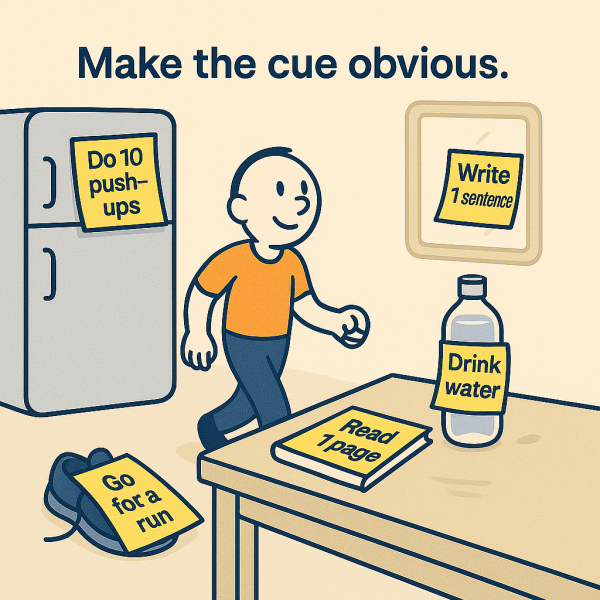
If you want to build a better habit, it all starts with the cue—the trigger that kicks off the behavior. In this section, we’ll look at simple ways to “hack” your cues so good habits are easier to start (and bad ones are easier to avoid).
Start With a Habits Scorecard
Most of us go through our day on autopilot. In fact, studies suggest that over 50% of what we do daily is habit-based—and we’re barely aware of most of it.
That’s why the first step in building better habits is simple: pay attention.
James Clear recommends starting with a habit scorecard.
Here’s how it works:
- Write out everything you typically do in a day, from waking up to going to bed.
- For each action, mark it as + (positive habit), – (negative habit), or = (neutral).
Even something as basic as checking your phone right after waking up counts. This exercise raises your awareness—because you can’t change what you don’t notice.
Clear compares it to a method used in the Tokyo train system called “Pointing and Calling.” Conductors literally point to indicators and call them out (“Signal: green. Speed: check.”) to stay alert. It sounds silly—but it reduced mistakes by 30%. Awareness matters.
Set Implementation Intentions
Most people say things like “I want to work out more” or “I’ll start eating better.”
But vague goals fade fast. That’s why researchers suggest using something called an implementation intention—a simple formula:
Implementation Intention: “I will [behavior] at [time] in [place].” For example: “I will run for 20 minutes at 8 a.m. on Tuesday.”
In one study, people who used implementation intentions were twice as likely to follow through on their exercise plan.
Why does it work? Because you’ve made the decision before the moment comes. That way, your brain doesn’t have to debate it when the time arrives.
Practice Habit Stacking
Another trick? Hook a new habit onto something you already do.
This is called habit stacking, and it follows a simple rule:
Habit Stacking: “After [current habit], I will [new habit].” For example: “After I brush my teeth, I’ll put on sunscreen.” Or: “After I pour my morning coffee, I’ll write one sentence in my journal.”
You’re turning your current routines into reliable triggers. Instead of trying to remember every habit separately, you chain them together—so they become part of a smooth routine.
- Habit Tracker: You can’t change what you don’t notice—start by tracking your daily habits.
- Implementation Intentions: Be specific: use clear time-and-place plans to follow through.
- Habit Stacking: Stack new habits onto existing ones to make them easier to remember.
🛋️ 6. Design Your Environment for Success: Your surroundings shape your behavior more than your willpower ever will.
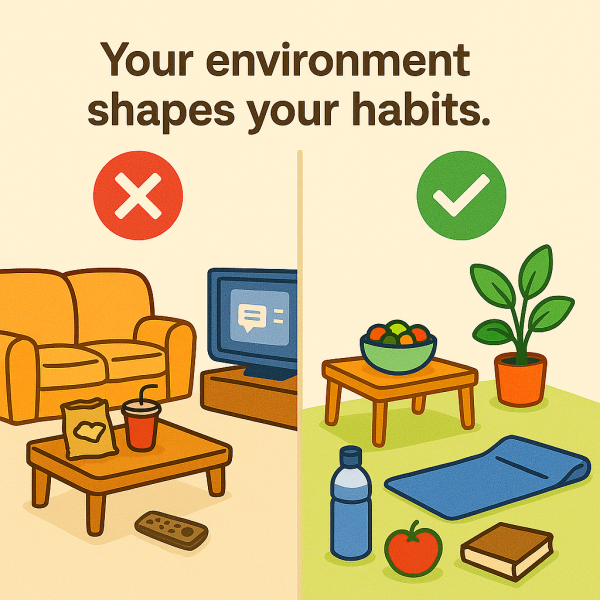
We often overestimate the power of motivation, thinking we just need to try harder. But in reality, the most consistent habits come from shaping your environment—not relying on willpower.
Make the Cue Visible
We respond to visual triggers constantly. If you want to build a habit, the easiest way to start is by making the cue obvious in your environment.
- James Clear used to forget about the apples he bought—until he put them in a bowl on the kitchen counter. Suddenly, he was eating them every day.
- Want to play more guitar? Take it out of the closet and leave it in the middle of your room.
- Want fewer distractions? Put your phone in a drawer while you work.
What you see shapes what you do. Change what’s around you, and your behavior will follow.
Small Tweaks, Big Results
In a six-month hospital study, researcher Anne Thorndike helped people drink more water—without saying a word. She simply placed baskets of bottled water around the cafeteria.
The result? Water sales jumped 25%, and soda sales dropped 11%. Just from changing what people saw.
Retailers know this well. Products placed at eye level sell far better than those hidden away. It’s not about willpower—it’s about visibility.
Set Up Your Space for Success
Habits are rarely triggered by just one thing. They’re built on a cluster of cues. Think of someone who comes home, drops their bag, sits on the couch, and turns on the TV. That routine is driven by dozens of familiar signals.
That’s why it helps to define clear spaces for different activities:
- A desk for work, not your bed or kitchen counter
- A reading corner for focus, not a noisy couch with the TV nearby
- A relaxing spot without your laptop, so your brain can actually unwind
James Clear found that when he worked all over his house, it was hard to stop working. Now, he uses a dedicated space—so when he leaves that area, work stops too.
Remove Temptation
We’re often told the key to breaking bad habits is to have more discipline. But that’s backwards.
People with strong habits don’t resist temptation all day—they just design lives where they don’t face as much of it.
One powerful example: During the Vietnam War, 15% of U.S. soldiers were addicted to heroin. Experts feared a massive drug crisis when they came home. But something unexpected happened—90% of them quit immediately after returning.
Why? Because the environment changed. The war, the stress, the cues—all gone.
Compare that to most rehab patients who return to the same friends, same places, and same routines. Their relapse rate? Over 90%.
- We rely too much on motivation—your environment influences you more.
- Make the cues for good habits visible so you remember to start them more often.
- Do the opposite for bad habits. The fewer temptations around you, the less discipline you need.
🎯 7. Make Good Habits Desirable: If you want a habit to stick, make your brain want to do it using dopamine.
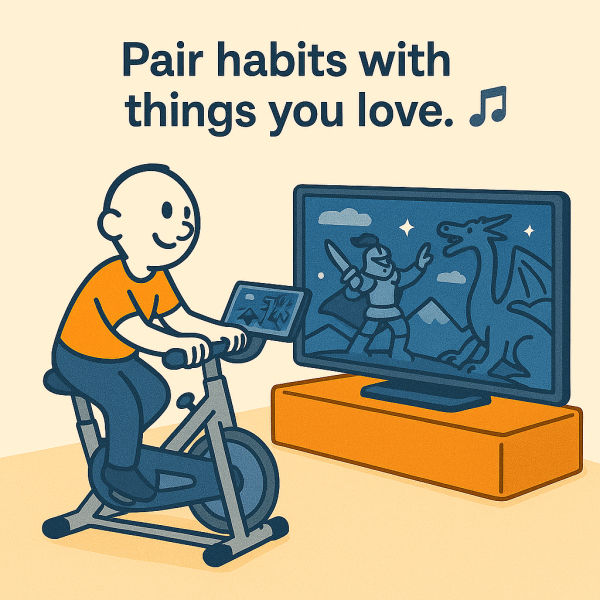
We tend to think of habits as logical choices. But underneath, most of our behavior is driven by craving—that surge of motivation we feel in anticipation of a reward. It’s the second part of the habit loop. This section explores how to harness that craving to build better habits—and weaken the pull of bad ones.
Your Brain Runs on Dopamine
At the core of craving is dopamine—a brain chemical that fuels motivation. When scientists blocked dopamine in lab mice, the animals lost all drive. They wouldn’t eat, drink, or even move. But when mice were given a lever to trigger dopamine? They would press it hundreds of times per hour, ignoring food and sleep.
Sound familiar? That same dopamine system makes humans scroll endlessly, binge-watch shows, or pull slot machines. We crave stimulation, and dopamine is the spark.
But here’s the catch: our modern world is full of hyper-stimulating “supernormal” triggers—junk food, TikTok, pornography, shopping apps, refined liquor, unrealistic models, video games, etc. These are exaggerated versions of things our brain is wired to seek, and they hijack our motivation systems.
Even animals are vulnerable. In one experiment, baby seagulls were shown fake beaks with extra-large red dots—a supercharged version of the red spot on their parents’ beaks that tells them where to peck for food. The chicks actually ignored their real parents and went crazy pecking the fake beaks instead.
Temptation Bundling: Pair the Habit With a Treat
If a good habit feels boring or effortful, pair it with something you enjoy. This is called temptation bundling. For example: One engineer connected his exercise bike to Netflix—he could only stream shows while pedaling.
Another way to do this: reward yourself right after a good habit. For example, only let yourself check sports scores after doing the dishes.
By linking a habit to something you already crave, you make the whole process more appealing.
Make It Socially Attractive
We are wired to care—deeply—about what other people think. Evolution shaped us to seek belonging, approval, and respect from the group. We’re strongly influenced by those around us. For example: Research shows you’re 57% more likely to gain or lose weight if your close friend does.
James Clear shares a powerful example: A Hungarian educator named László Polgár believed that any child could become a genius with the right environment. He raised his three daughters in a home completely focused on chess—surrounded by chess books, praised for chess skills, and taught to admire great players. The result? Two became chess grandmasters, and the youngest was the world’s top female player for 27 years. Their deep motivation wasn’t random—it was shaped by their environment.
So if you want to make a habit stick, surround yourself with people who value it. If you want to work out more, join a fitness group. Or if you want to read more? Find a book club.
Flip the Script on Bad Habits
You can also reduce cravings by making bad habits less attractive.
Many people have quit smoking cold turkey after reading Allen Carr’s Easy Way to Stop Smoking—a book that basically repeats over and over how terrible and pointless smoking is. By reframing the habit as disgusting and irrational, the intense craving sometimes loses its power.
You can flip this in a positive direction too. Make good habits feel more rewarding by highlighting the long-term benefit. Like saying: “Skipping this $10 lunch is another step toward my dream vacation.” Or: “Going for this run means I’ll have more energy later.”
- Craving is what drives habits—dopamine motivates us toward rewards. The more you want a habit, the less effort it takes to stick with it. Many bad habits are designed to be super-stimulating.
- Make good habits more appealing by pairing them with something fun, surrounding yourself with people who already do them, and highlighting the benefits you’ll get.
⚡ 8. Make Good Habits Easy: Reduce friction to build momentum fast using the 2-Minute Rule and other techniques
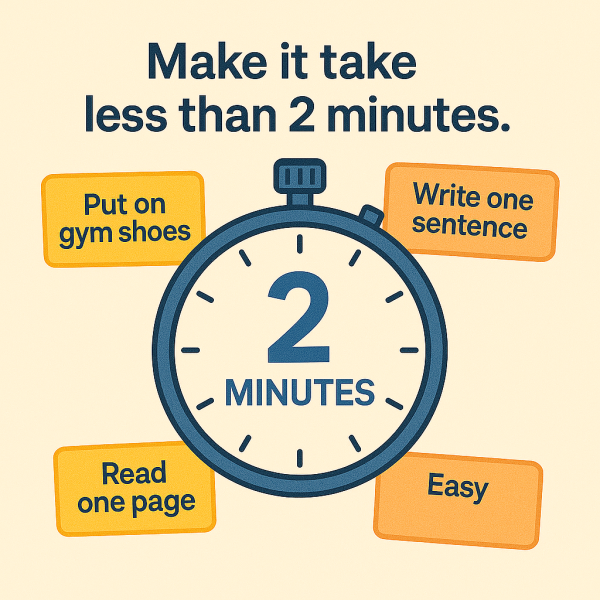
We like to think success comes from discipline and effort—but when it comes to habits, the key isn’t trying harder. It’s making the habit so easy, you can’t fail to start. This section focuses on the response part of the habit loop—the action you take—and how to make that action effortless.
Repetition Beats Perfection
When people start a new habit, they often focus too much on doing it perfectly—but that’s the wrong goal. What really matters is repetition. You don’t need to get it right every time—you just need to keep showing up.
A great example comes from a photography professor who split his students into two groups:
- Group A had to take 100 photos. They were graded on quantity.
- Group B had to take just one photo—but it had to be perfect.
In the end, the students who took more photos produced the best work. Why? Because they got more practice, made more mistakes, and learned more with every attempt. Quantity led to quality.
Neuroscience backs this up: the more often you repeat a behavior, the more automatic it becomes. Your brain literally rewires itself with each repetition.
In fact, brain scans show that areas of the brain linked to habit grow larger with practice. You can see this in musicians, chess players, and even London taxi drivers, who have an unusually large spatial memory center from memorizing complex street maps.
Remove Friction, Remove Excuses
Humans are wired to take the path of least resistance. So if you want to stick to a habit, reduce the friction between you and the action. That means removing steps in the process of starting it:
- Put your gym clothes by the door the night before.
- Keep healthy snacks prepped and visible.
- Choose a gym that’s on your commute, not across town.
This is why apps like Uber Eats, Amazon, and Tinder are so attractive—they remove steps and make things easier for us, whether ordering food or getting a date. Ease wins.
On the other hand, if you want to stop a bad habit? Add friction:
- Delete social media apps from your phone.
- Unplug your game console and stash it away.
- Turn off notifications that distract you.
Here’s another technique…
Try the Two-Minute Rule
If you keep procrastinating, try shrinking the habit.
The Two-Minute Rule says: Start with a version of the habit that takes two minutes or less.
For example:
- Instead of “read for 30 minutes,” say “read one page.”
- Instead of “work out,” say “do 10 push-ups.”
- Instead of “journal daily,” say “write one sentence.”
It’s not about doing less—it’s about making it easy to start. Once you begin, momentum kicks in. Starting to read one page often leads to reading for 15. That’s how habits grow—from a small start that feels effortless.
If you make the habit feel big from day one, your brain resists. But if it feels tiny and doable? You’re on the on-ramp, and the rest is smooth sailing.
🔐 Use Commitment Devices to Lock In Future Behavior
A commitment device is a clever trick: it’s something you set up now that helps you make better decisions later—by removing the need for willpower when the moment comes.
For example, author Victor Hugo was missing deadlines because he kept going to social events. So he had his assistant lock away all his nice clothes, making it impossible to go out. With no distractions, he stayed home and wrote. Six months later, The Hunchback of Notre Dame was done.
Today, we can use technology to guide our future behavior, so that discipline is automatic:
- Author Nir Eyal plugged his Wi-Fi router into a timer outlet that shut off his internet at 10 p.m.
- You can set up automatic bank transfers that move money into savings before you even see it.
- Or turn off app notifications, so distractions never reach you.
The goal is to design your surroundings so doing the right thing is the easiest option.
- Repetition makes habits automatic and easy—so don’t wait to be perfect, just start.
- Remove steps in the process to make good habits easier, and add friction to slow down bad ones.
- Use the Two-Minute Rule—start with the easiest version of a habit to beat procrastination.
- Set up commitment devices now to help your future self stay on track.
🍭 9. Make Good Habits Satisfying: Use immediate gratification to reinforce a habit
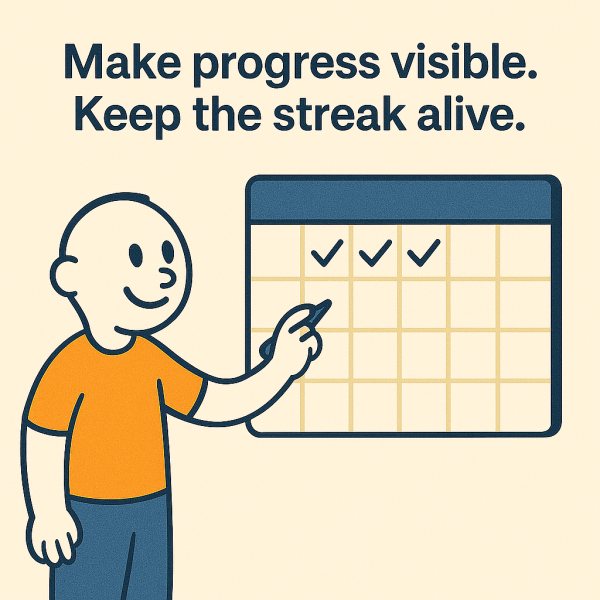
Humans are wired for instant gratification—it’s part of our evolution. That’s why it’s easy to binge a show, eat junk food, or scroll endlessly… and so hard to stick to habits like saving money, eating healthy, or exercising, which only pay off later.
James Clear calls this the Cardinal Rule of Behavior Change: You must make good habits immediately rewarding if you want them to stick.
Add a Satisfying Reward
Here’s a great real-world example: In a low-income area of Karachi, Pakistan, most people knew they should wash their hands—but they didn’t do it consistently. Instead of just offering education, researchers gave out premium soap that smelled amazing and felt good to use.
The result? Handwashing habits improved dramatically. Rates of diarrhea fell by over 50%, and the habit stuck for years. Why? Because they made the habit feel good right away.
You can use this principle too. After completing a habit, give yourself a small reward—even something like a piece of chocolate, sipping your favorite tea, or listening to a favorite song. That emotional satisfaction reinforces the habit loop.
Track Your Progress (and Make It Visual)
Another way to make habits satisfying is to see your progress. For example, Comedian Jerry Seinfeld put an X on the calendar every day he wrote jokes—his goal was to “never break the chain.” With this simple tool, he became one of the world’s top comedians.
Visual habit tracking works because it provides a visible, feel-good reward. It helps us stay motivated and feel like we’re making progress towards important milestones. A bank salesman used two jars of paper clips. One jar had 120 clips. Each time he made a sales call, he moved a clip to the other jar. He stuck with it—and started earning six figures.
What if you miss a day? Don’t worry. Just follow the golden rule: Never miss twice. One missed day won’t ruin your progress—quitting will.
Make Bad Habits Immediately Unpleasant
Bad habits are hard to break because they feel good now and bad later. So the trick is to flip that script: add an immediate cost to the bad habit.
That’s what laws do. People didn’t start wearing seatbelts just because it was smart—they did it because they’d get fined. Once seatbelt laws were passed, usage jumped from 15% to over 90%.
You can apply this in your own life using a habit contract. It’s a simple agreement where:
- You commit to your habit
- You assign a consequence for failing
- You involve an accountability partner who helps hold you to it
Example: An entrepreneur made a deal to pay their trainer $200 every time they skipped a workout. That financial (and social) consequence made skipping way less tempting.
Even without money on the line, knowing someone’s watching can be a huge motivator. We don’t like letting others down—especially people we respect.
- Instant rewards help habits stick—long-term benefits are not usually very motivating. Add some immediate gratification to the end of a good habit.
- Use visual trackers to make progress feel satisfying. Aim for consistency, not perfection—never miss twice.
- To break bad habits, add an immediate cost using a habit contract or accountability partner.
🧗♂️ 10. Aim For Mastery: How to keep getting better after the habit sticks so you can reach an elite level
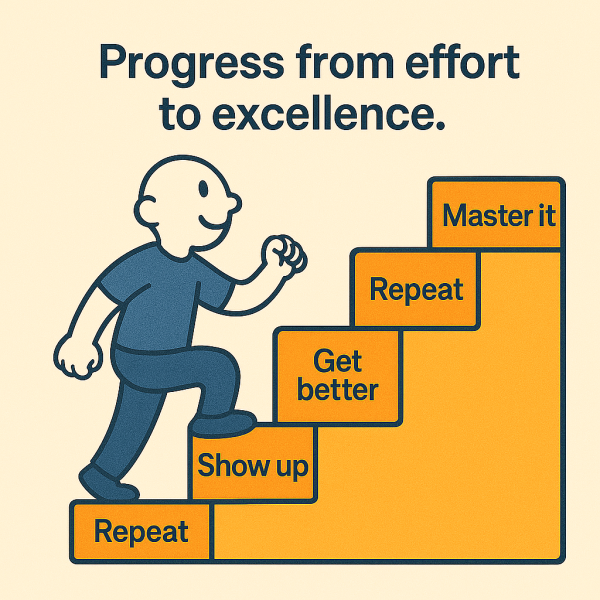
Once a habit becomes automatic, the next challenge is this: How do you keep improving without getting bored, stuck, or complacent? This section is about going from good to great.
Focus on What You’re Built For
You’ll always make faster progress in areas that come more naturally to you. That doesn’t mean you can’t succeed elsewhere—but it makes sense to pick a path where you have an edge.
Some people are built for certain skills physically (like swimmers with long torsos or runners with long legs). Others have personality strengths—like introverts who thrive in focused work, or extroverts who shine in group settings.
To find your natural strengths: Pay attention to where you lose track of time (this is called a flow state). And notice which things feel easier or click faster for you than others
Alternatively, you can combine a few skills you’re “pretty good” at into something unique Like Dilbert creator Scott Adams, who wasn’t the best cartoonist or funniest guy—but he combined decent drawing, office experience, and humor into a hit comic strip.
Mastery Feels Boring—Do It Anyway
After the excitement wears off, the hard part is just doing the work—over and over again.
One weightlifting coach said the best athletes aren’t the strongest or most talented—they’re the ones who can handle the boredom of doing the same lifts every day.
Most people quit when habits feel boring. But the pros stick with it. (This is a similar point to Steven Pressfield, who says that professionals show up every day even if they don’t feel like it or feel inspired.)
Still, you don’t want practice to feel mindless. To stay interested, gradually increase the challenge:
- Make your workout slightly harder
- Add 30 seconds to your meditation
- Tweak your writing goal or creative project just enough to stay sharp
Comedian Steve Martin started with tiny acts as a teen—and slowly stretched them until he could carry a full comedy show. 15 years of slow progress made him world-famous.
How to Keep Improving (Not Just Coasting)
Habits help automate tasks—but that can also cause your skills to plateau. If you want to keep improving, you need deliberate practice. Break down your big skill into smaller parts and push yourself to improve by 1%.
The 1980s L.A. Lakers did this by tracking their stats—points, assists, rebounds—and aiming to improve by just 1% per year. That steady improvement helped them become champions.
James Clear does something similar with two annual reviews:
- One review tracks measurable things like number of articles written and workouts completed.
- The other is an “integrity” review, reflecting on whether his habits still match his values.
Why both? Because some habits that once helped you might hold you back later. Growth means adjusting as you go.
- Pick habits where you have a natural advantage—your results will come faster.
- Mastery is about showing up daily, even when it gets boring.
- Avoid autopilot by gradually raising the challenge and tracking your progress.
Small Changes, Big Results
The book closes with an idea from ancient Greek philosophy: The Sorites Paradox. It asks: If one coin doesn’t make a person rich, then when does someone become rich?
The answer: When someone gets one coin after another, eventually one coin must be what makes someone rich.
And so it is with habits—because enough small steps always lead to something big.
One tiny change might not feel like much. But if you keep stacking small wins, one after another, you’ll wake up one day with a life that’s been transformed.
That’s the power of atomic habits.
- Start a Habit Scorecard: Write down your daily routine and label each habit as positive, negative, or neutral. This helps you see what’s actually happening and where to focus your efforts.
- Set One Clear Implementation Intention: Use the formula “I will [behavior] at [time] in [place]” to make your habit specific and easy to follow. For example, “I will stretch for 2 minutes at 7 a.m. in the living room.”
- Create One Habit Stack: Attach a new habit to something you already do. For example, “After I brush my teeth, I’ll read one page of a book.”
- Apply the Two-Minute Rule: Choose a habit and make the starting version take two minutes or less. If the habit feels too big, you’ll procrastinate—if it feels easy, you’ll start.
- Design Your Environment for Success: Put visual cues for good habits in plain sight and remove or hide the triggers for bad habits. Your surroundings should make the right action the easiest one.
- Track Your Habit Visually: Use a calendar, app, or notebook to mark every day you complete the habit. Seeing your progress builds momentum and makes the habit more satisfying.
- Use Temptation Bundling: Combine a habit you need to do with something you enjoy. For example, only listen to your favorite podcast while doing chores or walking.
- Make a Commitment Device: Set up something now that locks in good behavior later. This could be automatic savings transfers, a workout partner, or a browser blocker after 9 p.m.
- Use the “Never Miss Twice” Rule: Missing one day is normal—missing two starts a new (unwanted) habit. If you slip, focus on showing up the next day no matter what.
- Pick One Habit to Master: Choose a habit that fits your strengths or interests and aim to improve it just 1% at a time. Track your progress and gradually increase the difficulty to stay engaged.
If you get 1% better every day, how much better will you be in a year?
2x better
10x better
37x better
100x better
What is the correct order of the habit loop?
Response → Reward → Cue → Craving
Cue → Craving → Response → Reward
Cue → Reward → Craving → Response
Craving → Cue → Reward → Response
What’s the purpose of a habit scorecard?
To reward good habits
To plan new goals
To improve consistency
To raise awareness
What’s the main chemical behind habit craving?
Serotonin
Adrenaline
Dopamine
Cortisol
How can you stay engaged while practicing?
Keep raising the challenge slightly
Add daily rewards to practice
Change your habits weekly
Punish yourself for mistakes



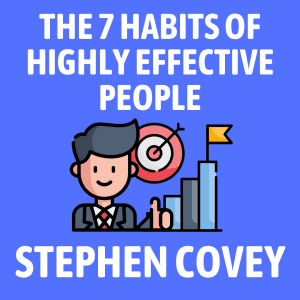

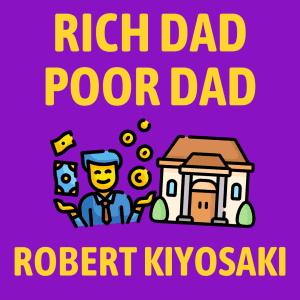
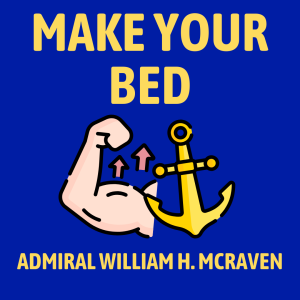
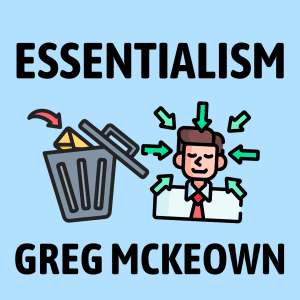
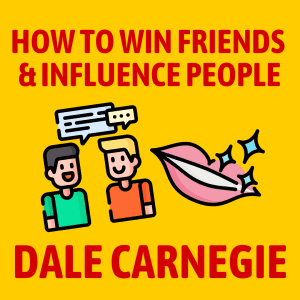


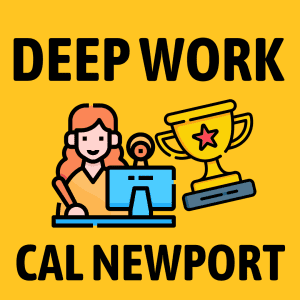


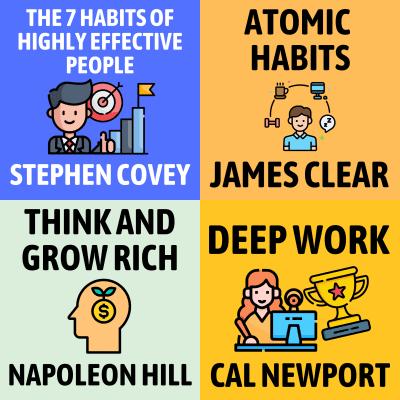


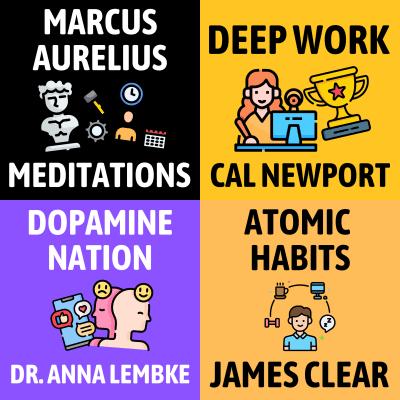

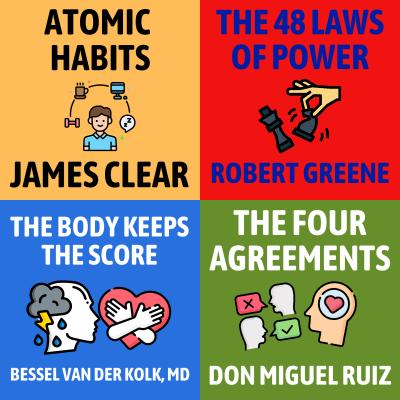

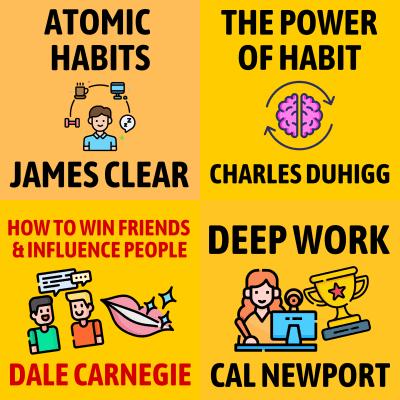
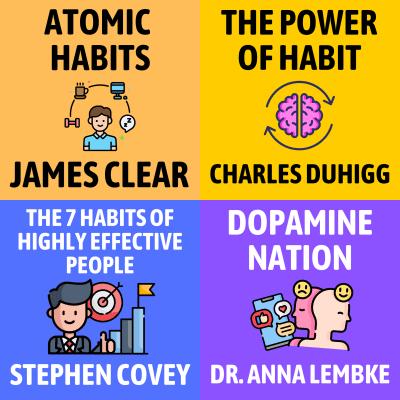
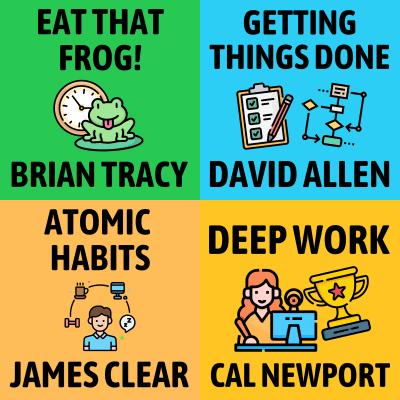

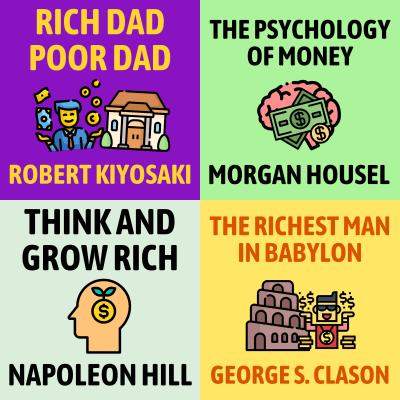
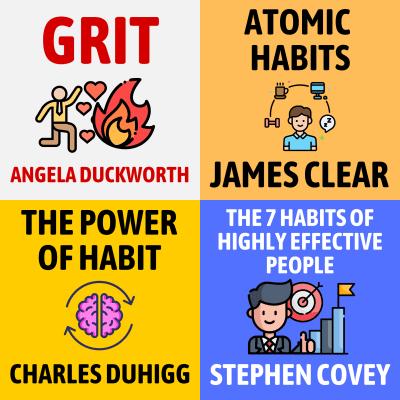













Community Notes